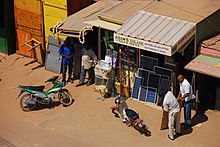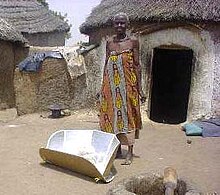

Renewable energy in developing countries is an increasingly used alternative to fossil fuel energy, as these countries scale up their energy supplies and address energy poverty. Renewable energy technology was once seen as unaffordable for developing countries.[1] However, since 2015, investment in non-hydro renewable energy has been higher in developing countries than in developed countries, and comprised 54% of global renewable energy investment in 2019.[2] The International Energy Agency forecasts that renewable energy will provide the majority of energy supply growth through 2030 in Africa and Central and South America, and 42% of supply growth in China.[3]
Most developing countries have abundant renewable energy resources, including solar energy, wind power, geothermal energy, and biomass, as well as the ability to manufacture the relatively labor-intensive systems that harness these. By developing such energy sources developing countries can reduce their dependence on oil and natural gas, creating energy portfolios that are less vulnerable to price rises. In many circumstances, these investments can be less expensive than fossil fuel energy systems.[4]
In isolated rural areas, electricity grid extensions are often not economical. Off‐grid renewable technologies provide a sustainable and cost‐effective alternative to the diesel generators that would be otherwise be deployed in such areas. Renewable technologies can also help to displace other unsustainable energy sources such as kerosene lamps and traditional biomass.[5]
Kenya is the world leader in the number of solar power systems installed per capita (but not the number of watts added). More than 30,000 small solar panels, each producing 12 to 30 watts, are sold in Kenya annually. Kenya was the first African country to use geothermal power, and still has the largest installed capacity of geothermal power in Africa at 200 MW, with a potential of up to 10 GW.[6]
- ^ "Developing Countries Lack Means To Acquire More Efficient Technologies". ScienceDaily. Retrieved 29 November 2020.
- ^ Frankfurt School-UNEP Centre/BNEF. Global trends in renewable energy investment 2020, p. 42.
- ^ "Changes in primary energy demand by fuel and region in the Stated Policies Scenario, 2019-2030 – Charts – Data & Statistics". IEA. Retrieved 29 November 2020.
- ^ Energy for Development: The Potential Role of Renewable Energy in Meeting the Millennium Development Goals pp. 7-9.
- ^ Cite error: The named reference
reeeewas invoked but never defined (see the help page). - ^ "China Climate Change Info-Net". Archived from the original on 5 November 2013. Retrieved 6 August 2013.
© MMXXIII Rich X Search. We shall prevail. All rights reserved. Rich X Search
